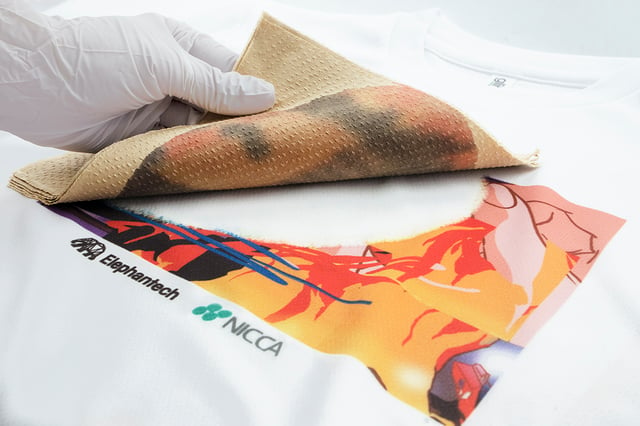Japanese / English
The "Neochromato Process" is a polyester textile decolorization technology jointly developed by Elephantech Inc. and NICCA CHEMICAL CO., LTD. that allows design and color changes to fabrics for improved reusability.
As the world's most used fiber, polyester accounted for 52%*1 of all fibers produced in 2019, with recycled polyester representing 14% of that total. Still, recycled polyester mostly comes from PET bottles and other uncolored, non-textile sector products as the decolorization of polyester fibers remains as one of the most significant hurdles to textile-to-textile recycling.
・Decolorization is completed in a waterless process by extracting disperse dye from polyester fabrics with a high-temperature solvent and simultaneously absorbing it into paper.
・A decolorized fabric can be printed on or dyed immediately after its decolorization process (including solvent removal), and colors and patterns can be changed as many times as necessary.
・Uses solvents made from wastes generated in the manufacturing process of other products.
・Uses less solvent than competing processes*2 (about the same amount as the weight of the product to be treated)
・Solvents can be collected and reused.
※1 Textile Exchange Preferred Fiber & Materials Market Report 2020
※2 Comparison with one method of decolorization during chemical recycling and two methods of decolorization by applying solvent vapor.

The newly developed Neochromato Process enables polyester fabrics to go through countless color and design changes, allowing garments and similar products to be recycled and reused in their original form, improving product lifespan and environmental impact compared to chemical or mechanical recycling methods.
In fact, the 48% reduction in CO2 emissions*3 allowed by this method of reusing garments compares very favorably to chemical recycling of polyester (-20% CO2 emissions) where polyester is dissolved in a solvent.
The ability to recycle clothes in their original form and without going through sewing and other textile manufacturing processes allows the product's value to be maintained for longer and reduces its carbon footprint more effectively.
※3 Elephantech calculations, on the basis of disposable solvent and paper being used for the Neochromato Process.
【NICCA CHEMICAL】
We started our spontaneous, in-house extracurricular manufacturing club called “MO-SO (fantasy) Meeting” after being inspired by Elephantech Vice President Masaaki Sugimoto’s lecture at our innovation center. The development of this technology first began when Masaaki Sugimoto and Aguri Sagimori showed interest in a MO-SO Meeting experiment which involved blurring characters and patterns to make them indistinguishable. We then obtained the cooperation of Japan Polymark when considering practical applications of the technology. We named the technology "Neochromato process" after how the dispersed dye that shouldn’t wash off would mysteriously seep through and be transferred as if in paper chromatography. We hope to convey to the world our desire to reduce textile waste through upcycling and to use as little water as possible while doing so.
【Elephantech】
The development of this technology came about following a conversation we had with the artist Aguri Sagimori in which we realized that there could be a huge amount of clothing waste from the fashion industry should the Tokyo 2020 Summer Olympics be postponed and rebranded as TOKYO 2021, and that we somehow needed to develop a technology to upcycle it all. As it happened, the event was postponed but thankfully kept its TOKYO 2020 naming, avoiding the mass waste we feared. However, we also came to see that the fundamental issue was how many pieces of clothing are only worn a few times before being disposed of, and so we continued our trial-and-error process along with many stakeholders in order to perfect the technology. As a result, we ended up with a magical technology that can erase and reprint prints over and over again. We hope that this Neochromato process technology will be used by many and contribute in bringing an era where we can enjoy sustainable fashion.
The Neochromato process requires no equipment other than a heat press machine. In fact, in skilled hands, a simple clothes iron may suffice. In addition, water-less discharge printing on polyester is also possible with some backing paper and processing solution, although there remains the constraint of various parameters such as the type and quantity of the backing paper and the processing temperatures needing some fine-tuning depending on the kind of fabric it is used on and the amount of dye. In order to boost user adoption of the Neochromato process, we plan to start by proposing a PoC (Proof of Concept) project for the circular economy in which we will accompany our customers.
The entered information and personal information will only be used to respond to your inquiry and will be managed appropriately
by NICCA CHEMICAL and Elephantech.
